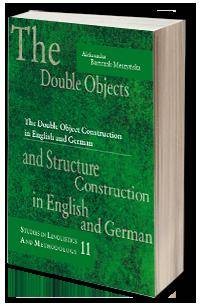The Double Object Construction in English and German. Studies in Linguistics And Methodology. Vol. 11
Aleksandra Bartczak-Meszyńska

| Dane szczegółowe: | |
| Wydawca: | Katolicki Uniwersytet Lubelski, KUL |
| Rok wyd.: | 2016 |
| Oprawa: | miękka |
| Ilość stron: | 240 s. |
| Wymiar: | 170x240 mm |
| EAN: | 9788380612020 |
| ISBN: | 978-83-8061-202-0 |
| Data: | 2016-10-12 |
Opis książki:
The Double Object Construction in English and German
Książka "The Double Object Construction in English and German. Studies in Linguistics And Methodology. Vol. 11" - Aleksandra Bartczak-Meszyńska - oprawa miękka - Wydawnictwo Katolicki Uniwersytet Lubelski, KUL. Książka posiada 240 stron i została wydana w 2016 r. Cena 38.03 zł. Zapraszamy na zakupy!
Spis treści:
List of Abbreviations
Historical sources
Introduction
1. Theoretical Framework
1.1 The origin of the Minimalist Program
1.2 Minimalist Program vs. GB theory
1.3 Operation Merge: External and Internal (Move)
1.4 Agree
1.5 Phases
1.6 Locality/Minimality
1.7 Feature inheritance/spread
1.8 A- and A -movement redefined
Summary
2. Double Object Construction- characteristics and outline of research
2.1 The Double Object Construction
2.2 Syntactic properties of objects
2.2.1 Direct Object
2.2.2 Indirect Object
2.3 Semantic features of objects
2.4 Syntactic structure of the DOC: Barss and Lasnik (1986)
2.5 The polemic between Larson and Jackendoff
2.5.1 Larson (1988)
2.5.1.1 V-Raising
2.5.1.2 Heavy NP Shift
2.5.1.3 Dative Shift
2.5.1.4 Consequences of DS
2.5.1.5 Constraints on DS
2.5.2 Jackendoff (1990)
2.5.3 Larson (1990)
2.5.4 Summary
2.6 The Applicative Head structure
2.6.1 Anagnostopoulou (2003)
2.6.2 Pylkkänen (2008)
2.6.3 Cuervo (2003)
2.7 Cross-linguistic variation in the characteristics of the DOC structure
2.8 Former accounts of asymmetries in the properties of the DOC - A cross-linguistic perspective
2.8.1 Ura (1996)
2.8.2 Anagnostopoulou (2003)
2.8.3 McGinnis (2001, 2005)
2.8.4 Jeong (2007)
2.8.4.1 Category
2.8.4.2 Availability of scrambling
2.8.4.3 Case assignment
2.9 Review of the questions
Summary
3 The structure of DOC and object displacement in German
3.1 Data
3.1.1 Unmarked Dative-Accusative DOC
3.1.2 Unmarked Accusative-Dative DOC
3.1.3 Double Accusative DOC
3.1.4 Ditransitive complementation (DC) with Prepositional Construction (PC)
3.1.5 Marked DOCs with a fronted object
3.1.5.1 Object initial sentences with Dat-Acc DOC
3.1.5.2 Object initial sentences with Acc-Dat DOC
3.1.5.3 Object initial sentences with double Acc DOC
3.1.5.4 Object initial sentences with the DOC with PC
3.2 Semantic characteristics of German DOC
3.3 Person Case Constraint in German DOC
3.4 Syntactic structure of German DOCs
3.4.1 Approaches aiming to combine Dat-Acc and Acc-Dat DOCs derivationally
3.4.2 Dat-Acc and Acc-Dat DOCs as separate phenomena (McFadden 2004)
3.4.3 Applicative Phrases in German
3.4.3.1 High and Low Applicative
3.4.3.2 Affected Applicative
3.4.3.3 Possessor Dative
3.4.3.4 The representation of double Acc DOC
3.4.4 Ditransitive complementation (DC) with PC
3.5 Case valuation in German DOCs
3.5.1 Dat-Acc DOC
3.5.2 Acc-Dat DOC
3.5.3 Double Accusative DOC
3.5.4 DC with PC
3.6 V2 and EPP
3.6.1 V2
3.6.2 EPP
3.7 Leftward object movement (to pre-V2 position)
3.7.1 Active sentences
3.7.2 Passive sentences
3.7.3 Kriegen/ Bekommen passive
3.8 Types of object movement
3.8.1 Object Shift
3.8.2 Scrambling
3.8.2.1 Pre-minimalist accounts
3.8.2.2 Minimalist approaches to Scrambling
3.9 Topics and Topicalization - Theoretical background
3.9.1 Topicalization - Definition
3.9.2 Topics - Main characteristics
3.10 Object displacement in the German DOC - Characteristics
3.10.1 Derivation of active sentences with a topicalized object
3.10.1.1 Dat-Acc DOC
3.10.1.2 Acc-Dat DOC
3.10.1.3 Double Accusative DOC
3.10.1.4 DC with PC
3.10.2 The computation of passive sentences with the DOC
3.10.2.1 Dat-Acc DOC
3.10.2.2 Acc-Dat DOC
3.10.2.3 Double Acc DOC
3.10.2.4 DC with PC
Summary
4 The structure of the DOC in English and object displacement patterns
4.1 Data
4.2 Semantic properties of the English DOC
4.3 Syntactic structure of the DOC in English
4.3.1 PC distinct from the DOC
4.3.1.1 Harley (2002)
4.3.1.2 Beck and Johnson (2004)
4.3.2 (Partially) Transformational Approach
4.3.2.1 Theme-Goal DOC in British English
4.3.2.2 Bruening (2010a)
4.3.2.2.1 Scope interactions between Quantifiers
4.3.2.2.2 Locative Inversion
4.3.2.3 Bruening (2010b)
4.3.3 PCC in the English DOC
4.4 Applicative structures in English
4.4.1 High Applicatives in English
4.4.2 Low Applicatives (Grashchenkov and Markman (2008))
4.4.3 Applicative with Linker
4.4.4 The representation of the DOC in English
4.5 Case in English DOC
4.5.1 The properties of Case in the DOC in the history of English
4.5.2 Case valuation in the present-day English DOC
4.6 Topicalization in English
4.7 Object fronting - An analysis
4.7.1 Active sentences
4.7.2 Passive sentences

